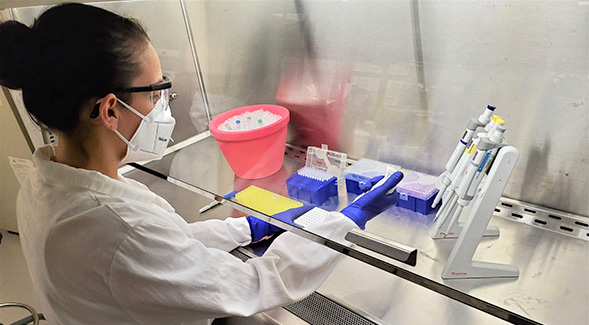SDSU Researchers Confront COVID-19: Understanding the Virus
More than 40 COVID-related projects at SDSU are tackling the coronavirus from nearly every angle.

In an extensive array of projects, San Diego State University researchers are investigating the characteristics and persistence of COVID-19.
Their research is critical for better understanding, diagnosing and ultimately treating the deadly virus. Many of the projects leverage SDSU’s community connections, allowing investigators to collaborate with local health care providers, medical companies, government agencies and nonprofits.
“SDSU faculty have faced the challenges of COVID-19 without hesitation,” said President Adela de la Torre. “We have the expertise, the critical connections, and the tenacity to confront major challenges head-on.”
This is the second in a five-part series highlighting more than 40 COVID-related projects taking place at SDSU. The work spans all seven of the SDSU’s academic colleges as well as the university’s Imperial Valley campus.
This installment focuses on efforts to improve our understanding of SARS-CoV-2, the virus that causes COVID-19. For information on all COVID-19 related research, visit research.sdsu.edu/covid-19-projects.
Diagnosing COVID-19
Biology professor David Lipson is collaborating with San Diego biotechnology company Menon Biosensors and University of California San Diego researchers to develop a new COVID-19 test using a combination of molecular biology and nuclear magnetic resonance technology.
The research aims to create a high throughput testing system that circumvents the need for standard real-time polymerase chain reaction (PCR) testing.
Surabhi Bhutani, a professor in the School of Exercise and Nutritional Sciences, is examining the relationship between loss of smell and taste and COVID-19. In partnership with colleagues, she developed an international questionnaire to assess perception in smell, taste and chemesthesis — the sensation of coolness from menthol or irritation, tingling, burning from chilies — before and during COVID-19.
Preliminary findings indicate these senses were significantly reduced in more than 4,000 participants diagnosed with COVID-19.
In another analysis of 15,000 questionnaire participants, Bhutani and colleagues found that smell loss during illness is the best predictor of COVID-19 status. This study resulted in the development of a COVID-19 rating tool that screens for recent smell loss.
Understanding COVID-19
How can we stop SARS-CoV-2 from replicating?
Chemistry professor Byron Purse and his lab are launching a new project that uses fluorescent probes to search for inhibitors of SARS-CoV-2 replication. His lab is applying its expertise on fluorescent modifications of DNA and RNA to create methods for studying the replicative processes of coronaviruses.
Molecules that inhibit viral replication form the basis of possible drug leads, and fluorescence-based methods are very valuable for identifying these inhibitors quickly and efficiently.
Chemistry professor Erica Forsberg is studying COVID-19-postitive blood serum samples from Sharp HealthCare. She will perform untargeted metabolomics, looking for novel metabolites and biomarkers associated with the virus. Forsberg aims to understand unique biological mechanisms in COVID-19 positive patients.
Evaluating persistence
Civil, construction and environmental engineering professors Natalie Mladenov and Matthew Verbyla, along with public health professor Kari Sant, are measuring SARS-CoV-2 in wastewater and evaluating its persistence in water. The researchers use spiking and degradation experiments, combined with sample collection from waterways with known wastewater contamination, to understand the persistence of SARS-CoV-2 in wastewater and surface water. The California State University COAST program and San Diego River Conservancy fund the $16,700 project.
Virology researchers Forest Rohwer and Naveen Vaidya are collecting and analyzing environmental samples for COVID-19. The research team is developing mathematical and computational models to predict COVID-19 risk and trends in different parts of San Diego. The project informs public agencies about how the virus spreads and determines if there are environmental reservoirs where the virus thrives. A $200,000 Rapid Response Grant from the National Science Foundation funds their work.
Read Part I in this series: Health care



